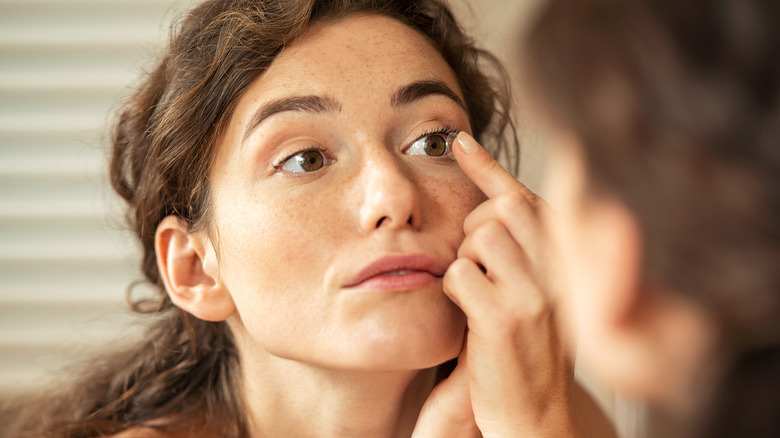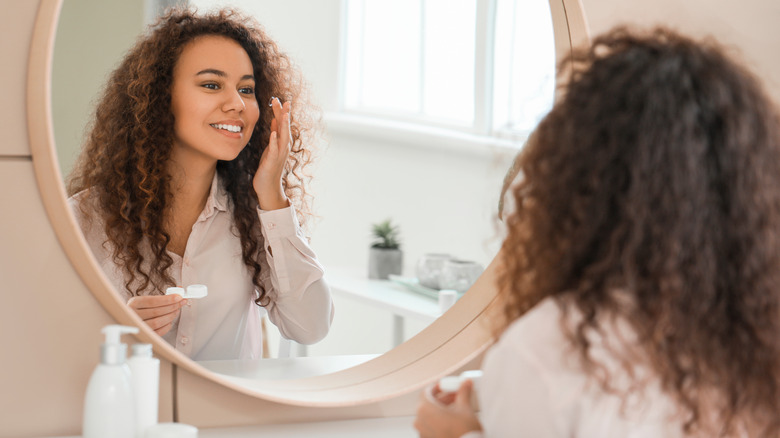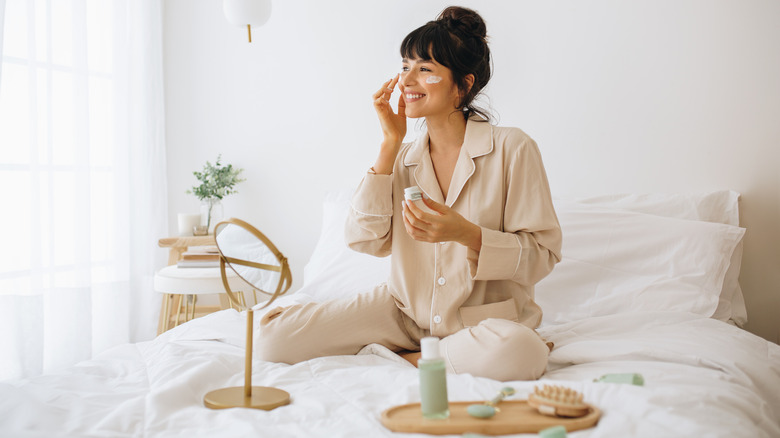The Correct Point In Your Makeup Routine To Put In Contacts
Whether you've been wearing contact lenses for years or have just started to use them, there's a chance that you might have become complacent with certain aspects of the necessary TLC. For instance, you might not wash them as well as you should or risk swimming with them in. You might also put your contacts and makeup on in the wrong order, which can lead to serious problems.
Frankly, there are quite a few nasty situations that can pop up if you aren't careful. That includes both bacterial and fungal infections, which can cause damage to the eye, as well as impair your sight, according to the Cleveland Clinic. In fact, when it comes to infections related to contacts, around 80% to 90% are caused by bacteria such as staphylococcus aureus or pseudomonas aeruginosa. The first is relatively difficult to deal with, while the second can threaten your cornea. Additionally, the Centers for Disease Control and Prevention notes that about one million trips to a doctor or hospital each year are due to an infection called keratitis, which is associated with contacts. That may not be so surprising when you find out that around 99% of people who were asked admitted to indulging in one or more bad habits concerning contacts.
If you're one of those people, then you should definitely change your ways. In order to do so, you need to know the perfect point in your makeup routine to put in your contacts.
Makeup can contaminate your contact lenses
The next time you do your makeup, make sure you've already put in your contact lenses. While that might leave you cringing if you've been doing things the other way around, contacts definitely need to go in first, and for a few very good reasons. For instance, if you need to pull your eyelid up or down in order to put in your lenses, you risk ruining any makeup you've so carefully applied. Although that alone is likely annoying enough to get you to tackle things in the ideal order, there are also health-related reasons you should know about.
If you put your lenses in after you've done your makeup, then tiny bits of debris from your concealer, eyeshadow or mascara could end up trapped between your contact and eyeball, according to LensPure. On top of that, any chemicals that have been used in the cosmetic's formula could find their way onto your contacts and end up irritating your eyes or even leading to infection.
This kind of scary situation can be caused by makeup that's cream-based, powder, or spray, which is why you want to do each step after you put in your contacts with your eyes closed if possible or shielded from any fallout or mist. At the same time, there are a couple of other tips you should keep in mind.
The right time to apply water and creams if you wear contacts
When you get ready to head out and face the world while slaying an absolutely fabulous look, popping in your contacts and putting on makeup is likely only a part of your overall routine. That's why, just like the timing of your cosmetics, you also need to ensure you're doing everything — and we mean everything — in the proper order. For example, while thoroughly washing your hands is obviously key, it's equally important to make sure that your fingers are completely dry in order to keep water away from your contacts. "Tap water has the potential to contain a parasite called an Acanthamoeba that can be dangerous to the eyes, so you never want your contacts or your contact case to come into contact with water," optometrist Susan Resnick explained to Allure.
On the other hand, you need to save your skincare routine for afterward. "You should insert your contacts before you do anything like putting on moisturizer...," Resnick said. "Anything that's left on your fingers can transfer onto the lenses, so you want to make sure your hands are squeaky clean."
Resnick also suggested that your beauty routine should involves keeping your contacts and lens case just as clean, saying, "You'd be surprised that cases are the most common cause of eye infections. And it's usually the top of the case, because no one ever thinks about that part." Fortunately, now you know!


